With only two possible answers, collecting feedback using Yes or No surveys is one of the most effective ways to maximize response and capture actionable insights.
Yes or no surveys, also known as dichotomous survey scales, allow respondents to provide quick and straightforward answers by choosing between two options: yes or no.
In this article, we will explore the advantages of using yes or no surveys, how to effectively use them, and provide some insightful use cases with respective questions. We will also discuss the different channels through which you can deploy yes or no surveys, including websites, offline, email, and SMS.
TL;DR
-
Yes or no surveys are simple and easy to answer, making them ideal for collecting customer feedback and insights. With only two possible answers, these surveys allow businesses to gather straightforward feedback on specific topics without requiring detailed explanations.
-
Dichotomous survey questions provide binary options of yes or no, allowing for quick responses and easy analysis.
-
Yes or no surveys are versatile and can be used in various scenarios, such as customer feedback, satisfaction surveys, product surveys, market research, and employee feedback.
-
Deploy yes or no surveys through different channels like websites, offline surveys, mobile app surveys, email surveys, and SMS surveys to maximize reach and response rates.
- Zonka Feedback is a versatile online survey tool that can be used by businesses to create a survey and send it to their target audience via different survey channels. You can schedule a demo with Zonka Feedback to understand how you use it for your yes or no surveys.
Measure Satisfaction with Yes or No Questions
With Yes and No Surveys, capture customer feedback and learn ways to delight them.

What are Yes or No Surveys?
Yes or no surveys are a type of survey that presents respondents with only two possible outcomes: yes or no. These binary choice questions are designed to be simple and straightforward, allowing respondents to provide quick answers without much thought or effort.
The simplicity of yes or no surveys makes them an ideal choice for gathering feedback in a variety of situations.
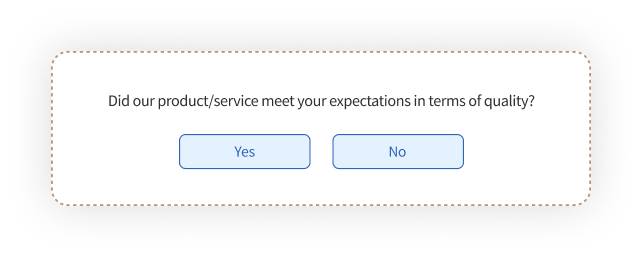
Businesses can use these surveys to collect opinions, preferences, or basic facts. With only two survey outcomes, these help gather data and more insightful responses in terms of customer satisfaction assessments, event feedback, and quick decision-making processes.
Advantages of Yes or No Surveys
Asking dichotomous questions offers a plethora of benefits. Not only do they enhance the survey experience because of their simplicity and ease of completion but they also offer ease of analysis to businesses. They're very user-friendly and are much easier to design, leading to a lower cost.
There are several advantages to using yes or no surveys. Here are some of the benefits:
-
Ease of completion: Yes or no surveys are easy to complete, as respondents only need to choose between two answer options. This reduces the cognitive load on participants, making it more likely for them to complete the survey with a positive survey experience.
-
Quick and easy analysis: Since the responses are binary, analyzing the results of yes or no surveys is relatively straightforward. It is easy to calculate percentages, compare responses, and identify trends, making it easier to draw meaningful insights from accurate data. This simplicity is particularly advantageous when dealing with large datasets or when a quick overview of trends is needed.
-
Versatility: Yes or no surveys can be used in a wide range of scenarios, including customer feedback, satisfaction surveys, product surveys, employee feedback, and much more. Their simplicity and ease of use make them suitable for various industries and purposes.
-
High response rates: Due to the simplicity of yes or no surveys, respondents are more likely to complete them. This can result in higher response rates, providing a more representative sample and increasing the reliability of the data collected.
-
Clear Data: The binary nature of the responses provides clear-cut data, making it easy to identify patterns, trends, or areas that require attention. This clarity is beneficial for decision-making and can guide actions based on the majority opinion. Yes/no surveys allow for standardized responses, reducing ambiguity in interpretation.
-
Specific Feedback Collection: Yes/no questions are effective for collecting specific feedback on particular aspects or criteria. They are well-suited for targeted inquiries, enabling organizations to address specific issues or concerns.
How to Use Yes or No Surveys Effectively
To effectively use yes or no surveys, consider the following best practices:
-
Keep it concise: Since the aim of yes or no surveys is to gather quick responses, keep the survey short and concise. Avoid overwhelming respondents with too many questions or unnecessary details.
-
Use clear and unambiguous language: Ensure that the questions are phrased in a way that leaves no room for interpretation. Use simple and straightforward language that is easy to understand.
-
Balance the number of yes and no questions: To avoid response bias, aim for a balanced number of yes and no questions. This will prevent respondents from falling into a pattern of always selecting one option.
-
Consider the order of questions: The order in which you present the questions can influence respondents' answers. Consider the flow and logic of the survey to ensure accurate and unbiased responses.
-
Provide an option for additional feedback: While yes or no questions provide valuable insights, they may not capture the full complexity of respondents' opinions. Include an open-ended question or comment box to allow participants to provide additional feedback or elaborate on their answers.
Yes or No Questions to Ask Based on Use Cases
Yes or no surveys can be applied in various use cases across industries. Here are some examples of yes or no questions to ask in different scenarios:
1. Dichotomous Questions for Customer Feedback
Yes or No surveys are an excellent tool for capturing customer feedback. They provide a quick and straightforward way for customers to express their opinions. By asking dichotomous questions, businesses can gather valuable insights to improve their products and services.
To effectively capture customer feedback, consider asking these dichotomous feedback survey questions:
-
Are you likely to continue using our product in the future?
-
Would you recommend our product to others?
-
Did our website meet your expectations?
-
Are you satisfied with the quality of our service?
-
Did we meet your expectations?
-
Did our product deliver the results you were looking for?
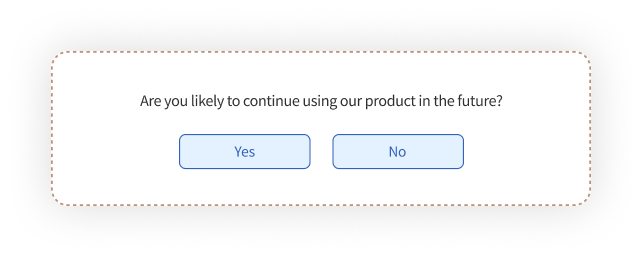
These types of questions can help gauge customer satisfaction and identify areas for improvement. With Yes or No surveys, businesses can gather feedback efficiently and make data-driven decisions to enhance the customer experience.
2. Product Survey Questions with Yes/No Answer Options
Product surveys can offer valuable insights into how customers perceive and interact with your products. They provide a straightforward way to gauge customer satisfaction and gather feedback that can lead to product improvements. When crafting a survey, consider asking product survey questions like:
-
Did you find our product easy to use?
-
Does our product offer all the features you expected?
-
Did our product meet your needs?
-
Would you purchase our product again in the future?
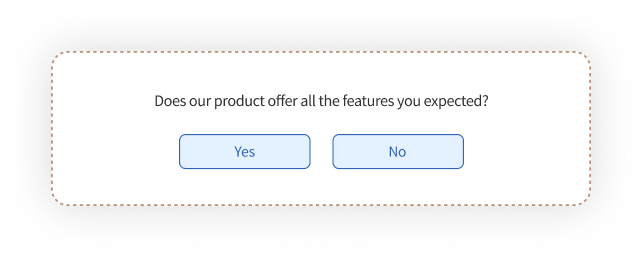
These concise Yes or No questions can yield actionable feedback that helps in refining your products to better meet customer expectations.
3. Dichotomous Questions for Market Research
Performing in-depth research of the market is vital for understanding how your brand is perceived and identifying potential areas for growth. Yes or No surveys can be a valuable tool in this regard. When using market research tools to conduct your surveys, you can try the following examples of dichotomous questions:
-
Are you familiar with our brand?
-
Have you heard about our latest product launch?
-
Are you interested in receiving updates about our new offerings?
-
Do you consider our brand trustworthy?
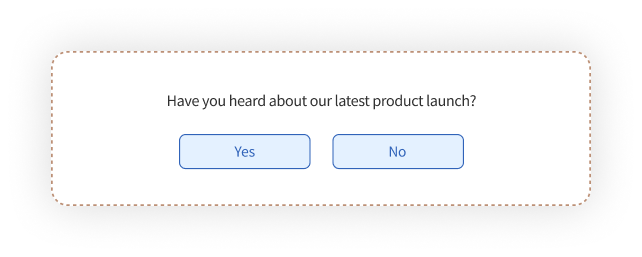
These succinct Yes or No questions can provide quick insights into brand recognition, product awareness, and trustworthiness among your target audience.
4. Employee Feedback with Yes/No Surveys
Gathering feedback from employees is crucial for maintaining a positive work environment and ensuring their satisfaction. Yes or No surveys can simplify this process. When seeking employee feedback, consider asking questions such as:
-
Do you feel valued and appreciated at work?
-
Do you have the necessary resources to perform your job effectively?
-
Are you satisfied with the communication within the company?
-
Do you believe your work contributes to the overall success of the organization?
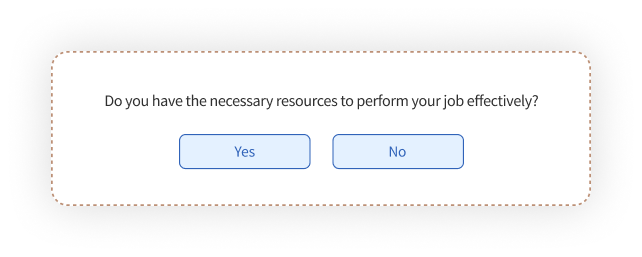
These Yes or No questions provide a quick and effective way to gauge employee sentiment, identify areas for improvement, and take action to enhance the workplace.
Other Use Cases and Dichotomous Question Examples
Apart from the major use cases discussed above, there are other scenarios where you can ask yes or no questions and get a deeper insight into the positive and negative aspects of things. You can use the survey data for sentiment analysis or simply dissect it further to understand how your customers truly feel about your business, product, or services.
5. Customer Satisfaction
Ask customer satisfaction questions and gauge loyalty by combining overall satisfaction with the likelihood of repeat business.
- Were you satisfied with the overall quality of our product/service?
6. Customer Service
When it comes to customer service surveys, you can be straightforward and ask if their issue was resolved or if they received the right assistance or not.
- Did the customer service representative effectively address your inquiry or concern?
7. Event Feedback
You can ask simplified dichotomous questions using Android survey apps and survey software to gather insights on both the content and logistics of the event to improve future planning.
- Did you find the event informative and engaging?
8. Website Usability
You can use website feedback tools and identify both positive and negative aspects of website usability to enhance the user experience.
- Was it easy to navigate our website and find the information you were looking for?
9. Health and Safety Measures
Ask health assessment questions with only two answer options to evaluate the perceived effectiveness of health and safety measures and identify potential challenges.
- Do you feel that the implemented health and safety measures are sufficient in the workplace?
Survey Channels to Collect Yes or No Surveys
Harnessing the simplicity and efficiency of Yes or No surveys is a strategic move for businesses looking to gather valuable insights. These surveys can be deployed through various channels, expanding their reach and ensuring robust response rates.
Here's a guide to the key survey channels:
1. Website Surveys
Integrating yes or no surveys into your website or blog is a great way to gather feedback from your visitors. By strategically placing the website surveys on relevant pages, you can capture feedback based on specific content or user experience.
While yes or no questions can provide valuable insights, they may not capture the full complexity of respondents' opinions.
To address this, consider including an open-ended question or comment box that allows participants to provide additional feedback or elaborate on their answers.
-
Seamlessly integrate Yes or No surveys into your website or blog to gather visitor feedback
-
Strategically place website usability surveys on relevant pages to collect input based on user experiences
-
When designing your survey, consider the order of questions to maintain accuracy and unbiased responses
-
Incorporate open-ended questions or comment boxes to capture more nuanced feedback
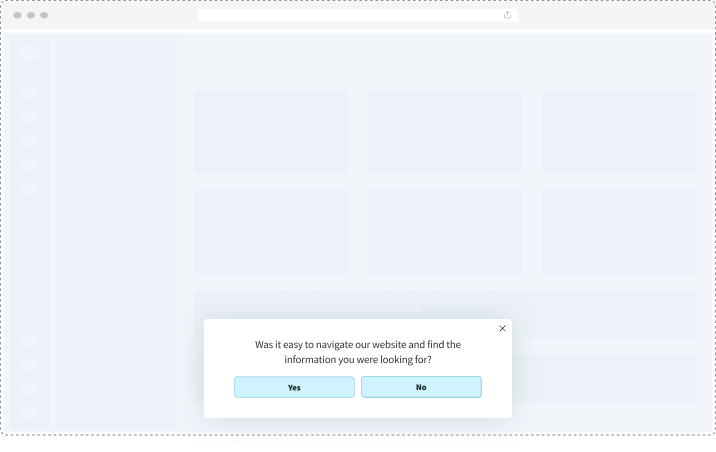
2. Offline Surveys
Businesses can utilize the best survey apps on their smartphones, tablets, iPads, and other handheld devices to capture field surveys and surveys in areas with restricted or no internet connection.
Whether at a bustling event booth, an industry conference, or during on-site customer visits, offline surveys enable organizations to gather valuable insights on the spot.
The simplicity of Yes or No responses ensures ease of participation, making it convenient for individuals to share their thoughts without the need for extensive explanations.
-
Engage with participants in person, whether at events, conferences, or customer visits
-
Provide data collection forms on tablets, iPhones iPads, or Android phones to facilitate quick Yes or No response
-
This channel is effective for capturing feedback during face-to-face interactions
3. Mobile App or In-App
When you have a mobile app to engage your customers with, asking dichotomous survey questions can help you gauge direct feedback regarding the app's usability, in-app experience, bugs, and much more. You can directly embed mobile app surveys within your apps without any technical expertise.
-
You can embed microsurveys in your app to gauge the feedback while the experience is fresh
-
Use in-app surveys to get real-time insights on app features, design, content quality, navigation, and more
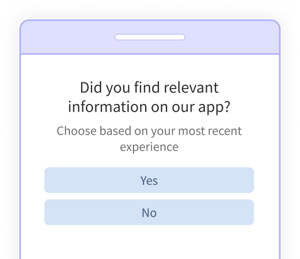
4. Email Surveys
Email surveys are also an effective way to gather feedback.
By sending customized email surveys to your target audience, you can encourage survey participants to respond with a simple yes or no.
-
Craft a clear subject line and concise email content to maximize engagement
-
Email surveys are a valuable channel for remote feedback collection
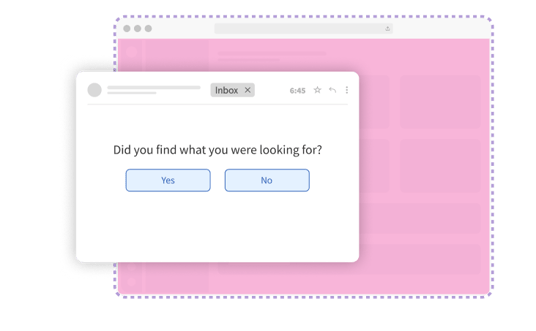
4. SMS Surveys
SMS surveys can also be utilized to reach respondents directly on their mobile devices, providing a convenient way for them to provide their responses. You can use SMS survey software to send our text surveys and gauge feedback from customers in real time.
-
Utilize SMS surveys to reach respondents directly on their mobile devices
-
Send brief messages containing survey links, allowing recipients to provide quick Yes or No responses
-
SMS surveys provide a convenient and user-friendly way for respondents to participate
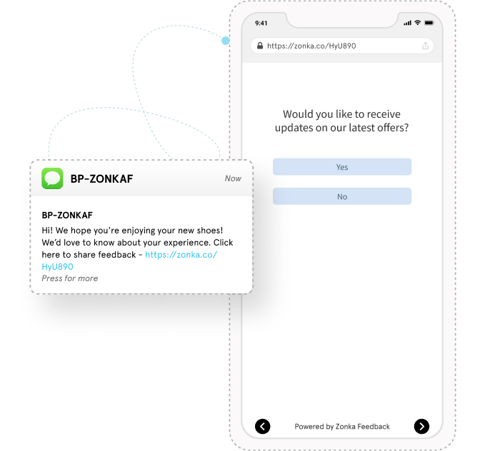
Closing the Feedback Loop: Leveraging Yes/No Survey Insights for Continuous Improvement
Once businesses have gathered valuable insights through yes or no surveys, the journey doesn't end there—it's just the beginning of a continuous improvement process. Closing the feedback loop involves taking proactive steps to implement changes, communicate improvements, and demonstrate responsiveness to customer feedback.
You can use survey software like Zonka Feedback to start creating your yes/no surveys and ask dichotomous survey questions. This tool can help you initiate a cycle of continuous monitoring and adaptation because of its factual reporting. They can also proactively share the improvement made based on the feedback shared by survey participants to keep them notified of how you are implementing their feedback.
It can lead to:
- Increased customer satisfaction
- Enhanced customer loyalty
- Gaining a competitive edge with an inclination towards commitment to improvement
- Fostering a culture of product/service innovation
Conclusion
Dichotomous questions offer a simple yet powerful way to collect feedback and gather valuable insights. They are easy to administer, provide quick responses, and allow for straightforward analysis. By using yes or no questions effectively and deploying them through various channels, you can gather valuable feedback from your customers, employees, and target audience.
So, consider incorporating yes or no surveys into your feedback collection strategy and start gathering valuable insights today!
Remember, the key to success lies in asking the right questions and using the data collected to drive meaningful improvements in your business or organization.
Use Zonka Feedback to create a survey and send out yes or no questions to your target audiences.
You can schedule a demo to explore how you can effectively use this survey tool.


.png)

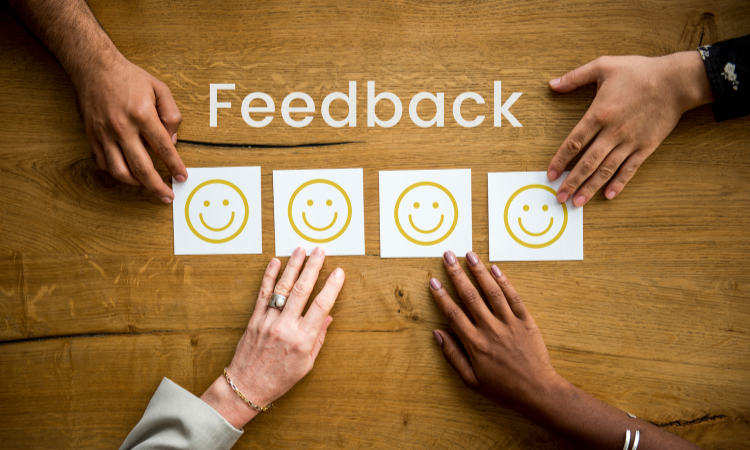


.jpg)



